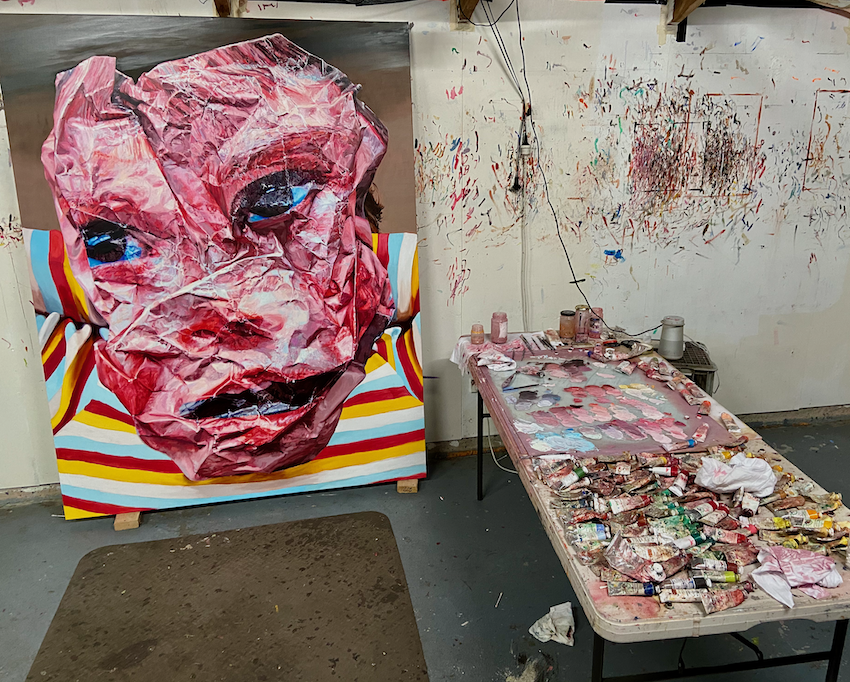Jennifer McEwan Bequest
The creation of Tasmanian Child oil on linen in the Premaydena Studio.
Jen, herself a creative, studied under legendary potter John Campbell. She travelled the world with her husband David, who worked for the Australian Wool Industry and was the 39th Australian Owner - Wool classer, visiting many art institutions such as the Guggenheim. Jen was aware of the evolving history and global legacy of art. She was drawn towards abstraction and spiritual works such as those of Paul Klee and Wassily Kandinsky. Jen also admired works by J.M.W Turner, Gerhard Richter and Tasmanian artists such as Philip Wolfhagen and Bea Maddock. In considering the commission I chose to further investigate figurative painting as is my current practice, aiming to trigger responses between my paintings and the portraiture collection in the Queen Victoria Art Gallery and Museum.
Historically women in painting lack ‘threat’ and are often represented as beautiful and harmonious. Jaqueline Rose states ”We know that women are meant to look perfect, presenting a seamless image to the world, so that man, in the confrontation with difference, can avoid any comprehension of lack. The position of women in fantasy therefore depends upon a particular economy of vision”
I am interested in theories of painting including Elizabeth Graw’s notion of Paintings’ ability to nourish vitalistic fantasy, triggering in the viewer the idea of the presence of the absent sitter. “It is through the act of painting – putting brush to canvas or panel – that the painters’ person appears to be brought into play, creating the phantasmatic impression of a presence that turns out to be an absence. The tension between the two – between presence and absence, between the suggestion of life and dead matter – is the source of the fascination of painted pictures.” “Painting, in other words, fosters the illusion that we can grasp what it represents but by the same token it withholds its presence from us. It thus suggests a presence and at the same time confronts us with an absence, an absence that can be representative of its creator who is often projected onto the work.”
Tasmanian Mother and Tasmanian Child are portraits of 6th and 7th generation Tasmanian's.
These paintings refer to the McEwan maternal lineage, the ghost trace of the feminine, and were painted from crushing a print of each sitter’s image. Distorting form is a technique used to integrate movement, into the ‘still’ picture frame and to raise questions about the discarded in our image saturated world, as well as raising issues of vulnerability of identity and vulnerability of the body.
Griselda Pollock Chapter 8 Painting, Feminism, History
Isabelle Graw, The Love of Painting, Genealogy of a Success medium, Sternberg Press, 2018, p 51
The creation of Tasmanian Child oil on linen in the Premaydena Studio.
Jen, herself a creative, studied under legendary potter John Campbell. She travelled the world with her husband David, who worked for the Australian Wool Industry and was the 39th Australian Owner - Wool classer, visiting many art institutions such as the Guggenheim. Jen was aware of the evolving history and global legacy of art. She was drawn towards abstraction and spiritual works such as those of Paul Klee and Wassily Kandinsky. Jen also admired works by J.M.W Turner, Gerhard Richter and Tasmanian artists such as Philip Wolfhagen and Bea Maddock. In considering the commission I chose to further investigate figurative painting as is my current practice, aiming to trigger responses between my paintings and the portraiture collection in the Queen Victoria Art Gallery and Museum.
Historically women in painting lack ‘threat’ and are often represented as beautiful and harmonious. Jaqueline Rose states ”We know that women are meant to look perfect, presenting a seamless image to the world, so that man, in the confrontation with difference, can avoid any comprehension of lack. The position of women in fantasy therefore depends upon a particular economy of vision”
I am interested in theories of painting including Elizabeth Graw’s notion of Paintings’ ability to nourish vitalistic fantasy, triggering in the viewer the idea of the presence of the absent sitter. “It is through the act of painting – putting brush to canvas or panel – that the painters’ person appears to be brought into play, creating the phantasmatic impression of a presence that turns out to be an absence. The tension between the two – between presence and absence, between the suggestion of life and dead matter – is the source of the fascination of painted pictures.” “Painting, in other words, fosters the illusion that we can grasp what it represents but by the same token it withholds its presence from us. It thus suggests a presence and at the same time confronts us with an absence, an absence that can be representative of its creator who is often projected onto the work.”
Tasmanian Mother and Tasmanian Child are portraits of 6th and 7th generation Tasmanian's.
These paintings refer to the McEwan maternal lineage, the ghost trace of the feminine, and were painted from crushing a print of each sitter’s image. Distorting form is a technique used to integrate movement, into the ‘still’ picture frame and to raise questions about the discarded in our image saturated world, as well as raising issues of vulnerability of identity and vulnerability of the body.
Griselda Pollock Chapter 8 Painting, Feminism, History
Isabelle Graw, The Love of Painting, Genealogy of a Success medium, Sternberg Press, 2018, p 51
